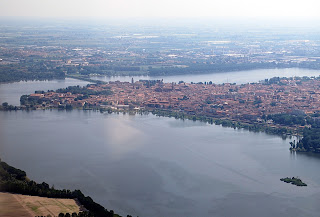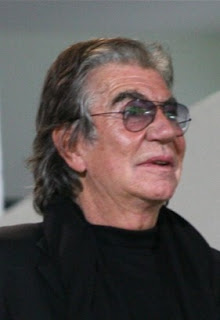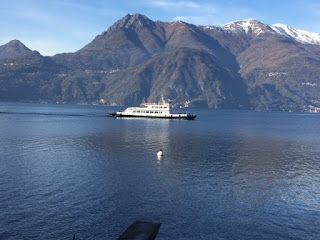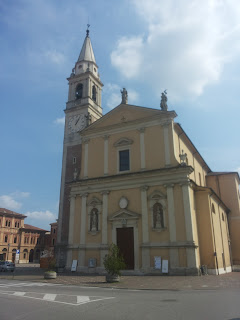Florentine became Medici court painter
 |
| Bronzino's portrait of Eleonora of Toledo, wife of Cosimo I de' Medici, with her son, Giovanni |
The Mannerist painter Agnolo di Cosimo – better known as Il Bronzino
or simply Bronzino – was born on this day in 1503, just outside Florence.
Bronzino is now recognised as the outstanding artist of what
has become known as the second wave of Mannerism in the mid-16th
century. His style bears strong
influences of Jacopo Pontormo, who was an important figure in the first wave
and of whom Bronzino was a pupil as a
young man in Florence.
The Mannerist movement began in around 1520, probably in
Florence but possibly in Rome. In the evolution of art it followed the High
Renaissance period.
Typical of Mannerist painters is their use of elongated forms
and a style influenced by the attention to detail allied to restrained realism
that was characteristic of the Renaissance masters Raphael, Michelangelo and
Leonardo da Vinci.
Bronzino became best known for his portraits, which were
detailed and stylishly sophisticated, in which the subjects were superbly realistic but also tended to wear stoical, rather haughty expressions.
He also paid particular attention to fabric and clothing,
his works often notable for his recreation of textures. He often used strong colours
- sometimes cold blues, at other times warm reds – and created effects that
were almost like theatrical lighting.
 |
| Cosimo I de' Medici in armour, as portrayed by Bronzino in 1545 |
He painted many religious works, in which the influence of
Michelangelo could be seen in his use of dramatic body shapes, but his
greatest contribution to the Mannerist period was his portraiture, particularly
during his time in the Medici court, where his ability to give his subjects an
air of elegant nobility made him very popular.
Born in Monticelli, then a small town just outside Florence
but now essentially a neighbourhood of the Tuscan city, Bronzino became
apprenticed to Pontorno in 1515, their relationship developing almost as that
of father and son. Indeed, when plague swept the city in 1522, Pontorno took
his pupil with him to stay in the relative seclusion of the Certosa di Galuzzo,
a monastery.
When they returned, Pontorno’s trust in Bronzino – who is
thought to have acquired his nickname mainly on account of a dark complexion, possibly due to a pigment disorder – was such that he enlisted his help in creating what is seen as his own masterpiece,
the Deposition from the Cross, an altarpiece in the church of Santa Felicità in
Florence, not far from the Ponte Vecchio, where they also worked together on a sidewall
fresco, Annunciation.
Indeed, Bronzino became so adept as following his master’s
methods that there has at times been fierce debate between experts over whether
certain paintings were the work of Pontorno or his pupil.
 |
| Bronzino's Portrait of a Young Man, painted in around 1540, is seen as one of his finest works |
Bronzino left the city for a second time in 1530 when it
came under siege from the armies of Spain and the Holy Roman Empire, who were
seeking to overthrow the Florentine republic established in 1527 and restore
the Medici family to power.
When he rejoined Pontorno in Florence some years later, he
had revealed his talent for portraiture while in the employ of the Duke of Urbino
and it was not long before he was appointed by the Medici court as official
portraitist, a role he would keep until he died in 1572, at the age of 69.
Bronzino’s figures influenced portraiture in Europe for
almost a century. His best-known works include portraits of the Grand Duke of
Tuscany, Cosimo I de' Medici, and his wife, Eleonora, and other members of
their court such as Bartolomeo Panciatichi and his wife Lucrezia. He also painted idealized portraits of the
poets Dante and Petrarch.
By the time of his death he had developed a relationship
similar to that he had enjoyed with Pontorno with his own pupil, the late
Mannerist painter Alessandro Allori.
 |
| The church of Santa Felicità in Florence |
Travel tip:
The church of Santa Felicità is described as the oldest
religious building in Florence, apart from the Basilica of San Lorenzo. Although the current structure was built in
1739, it is thought that the first church on the site was probably built in the
late fourth century. As well as Pontorno’s
painting, assisted by Bronzino, the church is famous for the fact that the Vasari
Corridor, the enclosed passage built by the Medici to link the Palazzo Vecchio
in Piazza della Signoria with the Medici’s family residence, the Palazzo Pitti,
passes through the façade.
 |
| Piero della Francesco's Flagellation |
Travel tip:
The town of Urbino in Le Marche has long been associated
with art, most famously as the birthplace of Raffaello Sanzio – better known by
the anglicised name, Raphael. Its
Galleria Nazionale delle Marche houses many fine works, including Raphael’s La
Muta, several paintings by Titian and Paolo Uccello and Piero della Francesco’s
Flagellation, measuring 59cm by 82cm and once described as ‘the greatest small
painting in the world’.
Also on this day:























